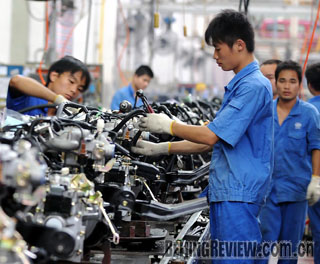| 
ADDED INCENTIVE: Changes in the country's VAT system
will leave more profits to enterprises
A couple of recent reports detailing the government's plan to further stimulate the country's economy next year have caused a pleasant stir among investors and enterprises alike.
A report issued on August 19 by Gong Fangxiong, Managing Director of JP Morgan Chase (Asia), said top government leaders are considering a stimulus plan worth 200 billion-400 billion yuan ($29.2 billion-$58.39 billion), including tax cuts. The plan would also maintain the stability of capital markets and promote healthy development of the wobbly real estate market. The report did not indicate the exact source of the information and was not verified by the government. But the day after it was issued, investors embraced the news and the Shanghai Composite Index surged 178 points.
Another article published in The Economic Observer in August said the government was considering a similar expansive fiscal policy, although no final decisions had been made. It said the Ministry of Finance (MOF) was considering a comprehensive tax cut policy to relax the government's tightening monetary policy and prevent the economy from slipping. The MOF had yet to hammer out the details about the implementation of the policy according to the needs of the overall economy, the article said. For instance, the ministry must determine whether it would have to make specific adjustments in implementing fiscal policy based on the government's overall budget, should the economy slide markedly and require stimulation through government expenditure. The ministry has already informed the State Council of the scheme of expansive fiscal policy it had discussed.
The government is slated to implement its 370-billion-yuan ($54.01 billion) economic stimulus package on January 1, 2009. It includes tax cuts of 150 billion yuan ($21.9 billion) and newly added expenditures of 220 billion yuan ($32.12 billion).
The article in The Economic Observer said the tax cut plan includes raising the individual tax threshold, increasing tax rebates, and implementing a preferential tax policy for small and medium-sized enterprises (SMEs). Newly added disbursements are mainly in the areas that involve people's livelihoods and investments, such as 45 billion yuan ($6.57 billion) for social security, 46 billion yuan ($6.72 billion) for agriculture, 38 billion yuan ($5.55 billion) for science, technology and education, 35 billion yuan ($5.11 billion) for public construction, 8 billion yuan ($1.17 billion) for subsidies for state-owned enterprises and 28 billion yuan ($4.09 billion) for energy, exports and the import of staple commodities.
An economic slide
Figures from the National Bureau of Statistics (NBS) show that in the first half of 2008, the country's GDP grew 10.4 percent year on year, which was 1.8 percentage points lower than the rate in the same period last year. An MOF report predicts that in the following months, the growth rate of fiscal revenue may continue to remain low.
| 